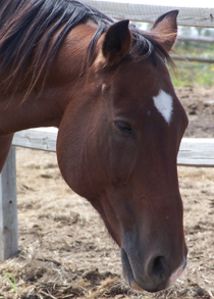The Horse's Pain–Free Back and Saddle–Fit Book

Behavior or performance issues related to saddle–caused back pain are often assumed to be training problems. …the horse is usually “disciplined,” trained more intensely, or sold. When, and if, saddle fit is addressed and the source of pain is removed, these “training problems” are quickly resolved.
In this book on saddle fitting and horse fitness, Joyce Harman seeks to help riders understand how saddle fit and other issues can affect their horses' performance. When a saddle does not fit properly, it is difficult for the horse to respond correctly to the rider's aids because he is preoccupied with pain. Harman states: “…it is imperative that, before you ask a horse to use his back and move forward and round in a frame, you acquire a saddle that fits you and your horse properly.”
Joyce Harman graduated from Virginia Maryland Regional College of Veterinary Medicine and is certified in veterinary acupuncture and veterinary chiropractic. She has extensively studied how saddle construction and saddle fit affects a horse's health and performance.
At first, one might think that a whole book on saddle fitting is excessive. A thorough reading of this book, however, can convince one otherwise.
The author addresses how the saddle should fit the rider as well as the horse. Harman claims that, “Most people have yet to sit in a saddle that fits them correctly.” The experience of riding in a proper saddle can be dramatic: “Instructors will often comment that the first time a student rides in a saddle that fits correctly, she can advance two years in one lesson.”
Harman explains this further:
There are many riders who do not know what “riding in balance” feels like. They have never experienced the freedom of movement that a well–fitting saddle provides to both rider and horse.
It is often easier to design a saddle to fit a rider than to fit a horse. While body position may vary slightly with the type of riding being done, there are basic things to consider: “The most stable leg position is when the pelvis is in neutral, the hip joint is in line with the ankle, and the stirrup leather hangs perpendicularly to the ground.”
Additionally:
When seat size is correct, you can sit in the center of the saddle with your seat bones pointing straight down. You will have the same amount of free space (2 to 4 inches) between you and the pommel as there is between you and the cantle…
In fitting the horse, one must consider numerous factors. Horses vary in both size and shape. Some of this is related to the horse's breeding. Other factors are more individualistic. And saddle fit can change as a horse ages and develops. Harman points out that a saddle purchased to fit a young horse may have to be exchanged as the horse grows. A saddle custom fitted for a horse with a physical problem may have to be altered as the problem is resolved.
Still, Harman is practical when it comes to cost. She points out that:
Saddle price is generally based on the quality of the leather, since leather is its most expensive feature. In general, however, the leather is less important than the quality of the construction.
The author writes about and illustrates numerous things to consider when selecting a saddle. Size, shape, design, and uniformity are all important. Harman is most experienced with "English" style saddles, but the information she presents can be very beneficial to “Western” riders as well.
One chapter of the book even addresses the professional who must ride a variety of horses and riding schools with an every-changing stock of horses. “…don't worry about ‘perfect’.” says Harman. “Sometimes ‘good’ is good enough…”
Besides saddles, Harman addresses the issue of saddle pads and how they can affect a horse's comfort. She states: “…in all cases, a pad should be used with a saddle that already basically fits.” While various pads and shims can help improve saddle fit, the common practice of simply using a thick pad to solve the problem of an ill–fitting saddle can actually make matters worse. As an example, Harman writes:
Often, pads sold to specifically cushion the withers, such as pommel pads and pads thicker in the front, can actually further compress the withers.
The final chapter of this book addresses other considerations in caring for a horse's back. These include various types of therapy, shoeing, and conventional veterinary practices as well as problematic horse management practices.
Anybody who cares about horses should be familiar with the issues addressed in this book. Additionally, a horse that is in pain and cannot move properly can be much more costly than the proper equipment and techniques necessary to keep that horse healthy, pain free, and usable.